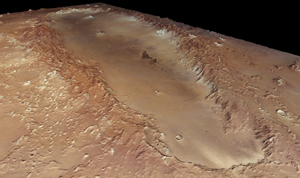Mysterie rond Marskrater

Vulkanisme als oorzaak?
Orcus Patera is an enigmatic elliptical depression near Mars’sequator, in the eastern hemisphere of the planet. Located betweenthe volcanoes of Elysium Mons and Olympus Mons, its formationremains a mystery.
Often overlooked, this well-defined depression extendsapproximately 380 km by 140 km in a NNE-SSW direction. It has a rimthat rises up to 1800 m above the surrounding plains, while thefloor of the depression lies 400-600 m below the surroundings.
The term ‘patera’ is used for deep, complex or irregularlyshaped volcanic craters such as the Hadriaca Patera and TyrrhenaPatera at the north-eastern margin of the Hellas impact basin.However, despite its name and the fact that it is positioned nearvolcanoes, the actual origin of Orcus Patera remains unclear
Komeetinslag
Aside from volcanism, there are a number of other possibleorigins. Orcus Patera may be a large and originally round impactcrater, subsequently deformed by compressional forces.Alternatively, it could have formed after the erosion of alignedimpact craters. However, the most likely explanation is that it wasmade in an oblique impact, when a small body struck the surface ata very shallow angle, perhaps less than five degrees from thehorizontal.
The existence of tectonic forces at Orcus Patera is evident fromthe presence of the numerous ‘graben’, rift-valley-like structuresthat cut across its rim. Up to 2.5 km wide, these graben areoriented roughly east-west and are only visible on the rim and thenearby surroundings.
Enigma
Within the Orcus Patera depression itself, the large graben arenot visible, probably having been covered by later deposits. Butsmaller graben are present, indicating that several tectonic eventshave occurred in this region and also suggesting that multipleepisodes of deposition have taken place.
The occurrence of ‘wrinkle ridges’ within the depression provesthat not only extensional forces, as would be needed to creategraben, but also compressive forces shaped this region. The darkshapes near the centre of the depression were probably formed bywind-driven processes, where dark material excavated by smallimpact events in the depression has been redistributed.
However, the presence of graben and wrinkle-ridges has nobearing on the origin of Orcus Patera, as both can be found allover Mars. The true origin of Orcus Patera remains an enigma.
Bron: ESA
Meest Gelezen
Vrouwen houden universiteit draaiende, maar krijgen daarvoor geen waardering
Wederom intimidatie van journalisten door universiteit, nu in Delft
Hbo-docent wil wel rolmodel zijn, maar niet eigen moreel kompas opdringen
‘Burgerschapsonderwijs moet ook verplicht worden in hbo en wo’
Raad van State: laat taaltoets nog niet gelden voor hbo-opleidingen
